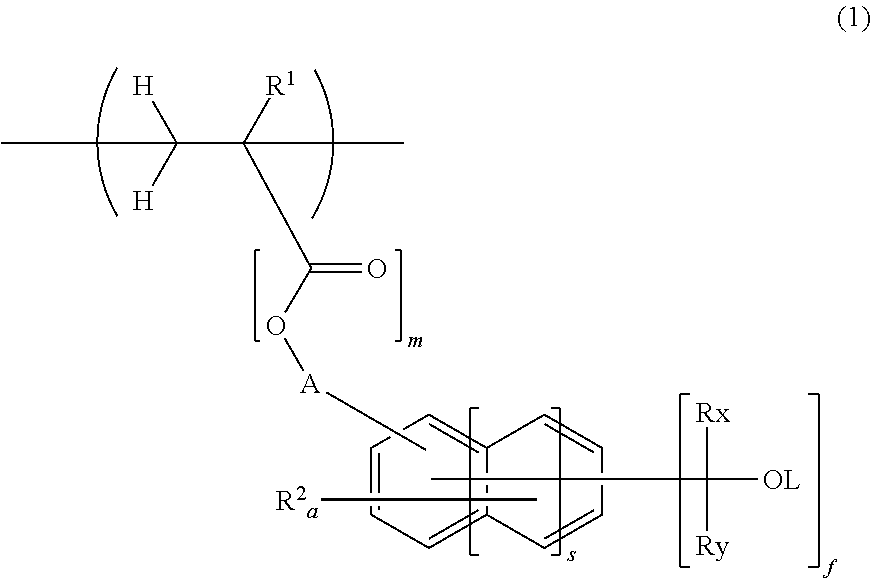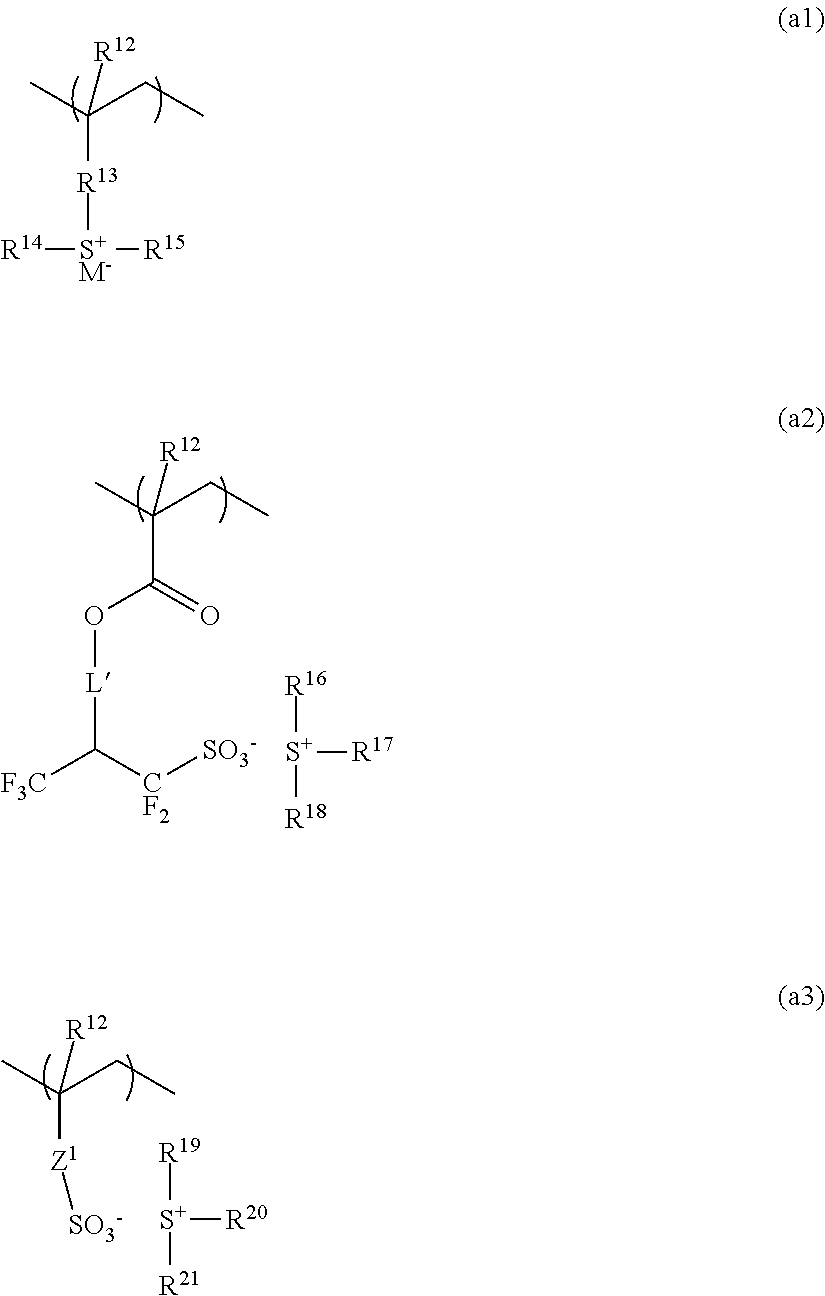Negative resist composition and pattern forming process
a technology of composition and resist, applied in the field of negative resist composition, can solve the problems of resolution and dimensional control of patterns, increase in bake temperature dependence of pattern size, and sensitivity reduction, and achieve the effects of reducing temperature dependence of feature size, reducing sensitivity, and reducing sensitivity
- Summary
- Abstract
- Description
- Claims
- Application Information
AI Technical Summary
Benefits of technology
Problems solved by technology
Method used
Image
Examples
synthesis example 1
Synthesis of Polymer 1
[0150]In a 3000-mL dropping funnel under nitrogen blanket, a solution was prepared by dissolving 890 g of 50.0 wt % PGMEA solution of 4-hydroxystyrene, 47.7 g of acenaphthylene, 169.6 g of 4-(2-hydroxy-2-propyl)styrene, 87.0 g of triphenylsulfonium 1,1,3,3,3-pentafluoro-2-methacryloyloxy-propane-1-sulfonate, and 96.1 g of dimethyl 2,2′-azobis(2-methylpropionate) (V601, Wako Pure Chemical Industries, Ltd.) in 360 g of γ-butyrolactone and 220 g of PGMEA as solvent. A 5000-mL polymerization flask was purged with nitrogen, charged with 580 g of γ-butyrolactone, and heated at 80° C. In this state, the solution was added dropwise to the flask over 4 hours. After the completion of dropwise addition, stirring was continued for 18 hours while maintaining the polymerization temperature of 80° C., The polymerization solution was then cooled down to room temperature and added dropwise to 22,500 g of diisopropyl ether whereupon a copolymer agglomerated. The diisopropyl ethe...
synthesis example 2
Synthesis of Polymers 2 to 14 and Comparative Polymers 1, 2
[0152]Polymers 2 to 14 and Comparative Polymers 1, 2 shown in Table 1 were synthesized by the same procedure as Synthesis Example 1 except that the type and amount of monomers were changed. In Table 1, a ratio of each unit incorporated is on a molar basis. Recurring units incorporated in polymers have the structures shown in Tables 2 to 5.
[0153]
TABLE 1Unit 1Unit 2Unit 3Unit 4RatioRatioRatioRatio(mol(mol(mol(molType%)Type%)Type%)Type%)Polymer1A-166.0B-29.0C-121.5P-13.52A-266.0B-210.5C-120.0P-13.53A-163.0B-112.0C-121.5P-13.54A-263.0B-112.0C-121.5P-13.55A-168.0B-210.0C-118.5P-23.56A-167.0B-29.5C-120.0P-33.57A-169.0B-210.0C-117.5P-43.58A-165.0B-29.5C-122.0P-53.59A-164.0B-210.0C-122.5P-63.510A-165.0B-310.0C-121.5P-13.511A-262.0B-410.0C-124.5P-33.512A-168.5B-28.0C-220.0P-13.513A-170.5B-28.0C-318.0P-13.514A-171.5B-29.0C-416.0P-13.5Compar-1A-175.5B-29.0——P-13.5ativeB-512.0Polymer2A-174.0B-110.5——P-13.5B-512.0
[0154]
TABLE 2A-1A-2
[0155...
synthesis example 3
Synthesis of Polymer 15
[0158]In a 200-mL dropping funnel under nitrogen blanket, a solution was prepared by dissolving 39.26 g of 4-acetoxystyrene, 6.14 g of acenaphthylene, 19.6 g of 4-(2-hydroxy-2-propyl)styrene, and 7.43 g of dimethyl 2,2′-azobis(2-methylpropionate) (V601, Wako Pure Chemical Industries, Ltd.) in 90 g of methyl ethyl ketone (MEK) as solvent. A 500-mL polymerization flask was purged with nitrogen, charged with 60 g of MEK, and heated at 80° C. In this state, the solution was added dropwise to the flask over 4 hours. After the completion of dropwise addition, stirring was continued for 18 hours while maintaining the polymerization temperature of 80° C. The polymerization solution was then cooled down to room temperature and added dropwise to 1,000 g of hexane whereupon a copolymer precipitated. The copolymer precipitate was collected by filtration and washed twice with 200 g of hexane. Under nitrogen blanket, the copolymer was dissolved in a mixture of 126 g of THE ...
PUM
| Property | Measurement | Unit |
|---|---|---|
| size | aaaaa | aaaaa |
| wavelength | aaaaa | aaaaa |
| mol % | aaaaa | aaaaa |
Abstract
Description
Claims
Application Information
 Login to View More
Login to View More - R&D
- Intellectual Property
- Life Sciences
- Materials
- Tech Scout
- Unparalleled Data Quality
- Higher Quality Content
- 60% Fewer Hallucinations
Browse by: Latest US Patents, China's latest patents, Technical Efficacy Thesaurus, Application Domain, Technology Topic, Popular Technical Reports.
© 2025 PatSnap. All rights reserved.Legal|Privacy policy|Modern Slavery Act Transparency Statement|Sitemap|About US| Contact US: help@patsnap.com



